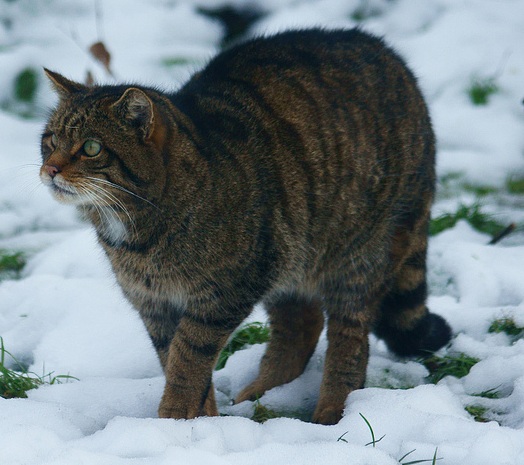Scottish Wildcats Are Interbreeding Themselves Into Extinction
One researcher thinks Scottish wildcats could be gone within two years thanks to hybridization with domestic house cats

A Scottish wildcat. Photo: Peter Trimming
Scottish wildcats, the U.K.’s only remaining species of wild feline, look a little bit like adorable grey tabbies, slightly on the large size, with a bushy striped tail. But the species lived in Scotland long before any domestic relatives—or humans—arrived. Nicknamed “the tiger of the highlands,” the felines were rumored for years to be man-killers. The Scottish Wildcats Association makes clear that these fierce felines are no cuddly kittens:
Although classically portrayed as a ferocious and terrifying beast to be feared and hated, wildcats simply enjoy their personal space, daily schedule and peace. A wildcat will only attack something it’s hunting, or something that it feel is hunting it. When threatened their classic strategy is to turn on an aggressor hissing, growling and spitting furiously; just like a domestic cat their hackles raise and the back arches but rather than turn side on to try and look big, they mock charge like a big cat; stamping forwards at you hissing and spitting. The idea is to give you just enough doubt to give them an opportunity to escape. If given no other choice and in fear of its life, perhaps cornered or defending kittens, the cat will attack with all its fury.
Yet only about 100 of the wildcats remain, and researchers point to the common house cat as the main culprit behind the species’ demise, the BBC reports. Wildcats and house cats, it turns out, are interbreeding, and scientists project the species could be obliterated by house cat genes within two years.
Paul O’Donoghue, a researcher calling for the species’ conservation, compared the 63,000 domestic cat genes to those of the wildcats. He combed through 140 years worth of wildcat specimens kept in London and Edinburgh museums in order to find pristine genetic samples, then compared those two standards to samples attained from wildcats in the wild.
O’Donoghue concluded that extinction due to hybridization is almost guaranteed, perhaps within two years, for the wildcat unless conservationists undertake drastic action. For him, that means trapping the wildcats that still maintain pure genes, breeding them, and perhaps even placing them in the care of volunteers—so long, of course, as there are no frisky house cats about.
More from Smithsonian.com:
Wild Things: Wildcats, Pigeons and More
Following the Track of the Cat
/https://tf-cmsv2-smithsonianmag-media.s3.amazonaws.com/accounts/headshot/Rachel-Nuwer-240.jpg)
/https://tf-cmsv2-smithsonianmag-media.s3.amazonaws.com/accounts/headshot/Rachel-Nuwer-240.jpg)